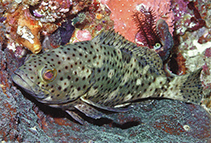| Family: |
Epinephelidae (Groupers) |
| Max. size: |
49 cm TL (male/unsexed) |
| Environment: |
reef-associated; brackish; marine; depth range 1 - 30 m |
| Distribution: |
Western Pacific: Thailand, Hong Kong, and Taiwan to Australia (Western Australia, Northern Territory, Queensland and New South Wales) and eastward to the Solomon and Mariana Islands, including Indonesia, Singapore, Philippines, Papua New Guinea, and Palau. Adults often misidentified as Epinephelus macrospilos. |
| Diagnosis: |
Dorsal spines (total): 11-11; Dorsal soft rays (total): 15-17; Anal spines: 3-3; Anal soft rays: 8-8. This species is distinguished by the following characters: greatest depth of body 2.9-3.2 in SL; ctenoid scales on body except cycloid scales anterodorsally and ventrally; body with auxiliary scales; gill rakers 8-10 + 14-17; pectoral-fin length 1.5-1.7 times in head length; rounded caudal fin; short pelvic fins, 1.8-2.3 in head length. Colour pale grey (sometimes with diffused white blotches) with small, widely spread black spots smaller than pupil on head, body and fins; 3 dusky to blackish blotches on body at base of rear half of dorsal fin, the largest at base of last 2-3 spines; dusky to blackish saddle spot on caudal peduncle; juveniles with black-edged white spots on head and body (Ref. 39231, 90102). |
| Biology: |
Common in shallow silty coastal reefs, sometimes in estuarine areas. The ovary was well developed in an examined fish of 30 cm SL. Solitary or in small groups (Ref 90102). |
| IUCN Red List Status: |
Least Concern (LC); Date assessed: 18 November 2016 Ref. (130435)
|
| Threat to humans: |
harmless |
Source and more info: www.fishbase.org. For personal, classroom, and other internal use only. Not for publication.
